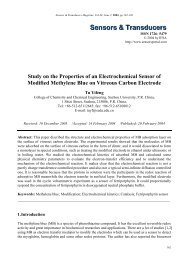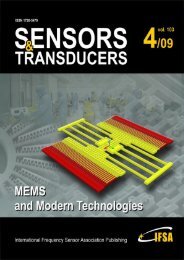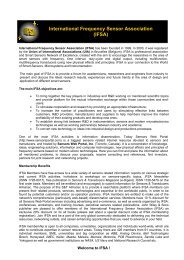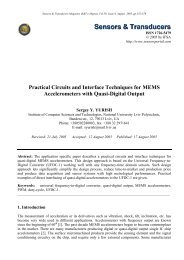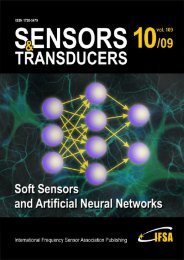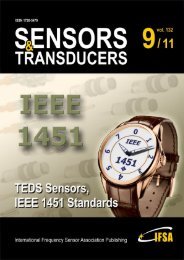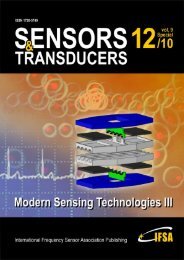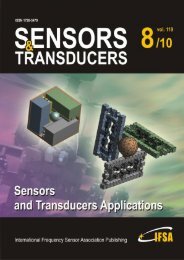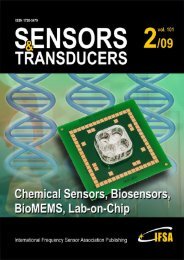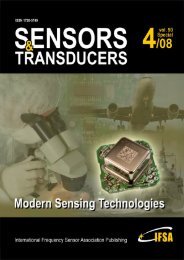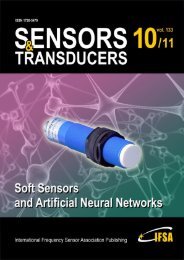Nanostructured Spinel ZnFe2O4 for the Detection of ... - ResearchGate
Nanostructured Spinel ZnFe2O4 for the Detection of ... - ResearchGate
Nanostructured Spinel ZnFe2O4 for the Detection of ... - ResearchGate
- No tags were found...
Create successful ePaper yourself
Turn your PDF publications into a flip-book with our unique Google optimized e-Paper software.
Sensors & TransducersVolume 134 Issue 11November 2011www.sensorsportal.com ISSN 1726-5479Editors-in-Chief: pr<strong>of</strong>essor Sergey Y. Yurish, tel.: +34 696067716, e-mail: editor@sensorsportal.comEditors <strong>for</strong> Western EuropeMeijer, Gerard C.M., Delft University <strong>of</strong> Technology, The Ne<strong>the</strong>rlandsFerrari, Vittorio, Universitá di Brescia, ItalyEditor <strong>for</strong> Eastern EuropeSachenko, Anatoly, Ternopil State Economic University, UkraineEditors <strong>for</strong> North AmericaDatskos, Panos G., Oak Ridge National Laboratory, USAFabien, J. Josse, Marquette University, USAKatz, Evgeny, Clarkson University, USAEditor South AmericaCosta-Felix, Rodrigo, Inmetro, BrazilEditor <strong>for</strong> AfricaMaki K.Habib, American University in Cairo, EgyptEditor <strong>for</strong> AsiaOhyama, Shinji, Tokyo Institute <strong>of</strong> Technology, JapanEditor <strong>for</strong> Asia-PacificMukhopadhyay, Subhas, Massey University, New ZealandEditorial Advisory BoardAbdul Rahim, Ruzairi, Universiti Teknologi, MalaysiaAhmad, Mohd Noor, No<strong>the</strong>rn University <strong>of</strong> Engineering, MalaysiaAnnamalai, Karthigeyan, National Institute <strong>of</strong> Advanced Industrial Scienceand Technology, JapanArcega, Francisco, University <strong>of</strong> Zaragoza, SpainArguel, Philippe, CNRS, FranceAhn, Jae-Pyoung, Korea Institute <strong>of</strong> Science and Technology, KoreaArndt, Michael, Robert Bosch GmbH, GermanyAscoli, Giorgio, George Mason University, USAAtalay, Selcuk, Inonu University, TurkeyAtghiaee, Ahmad, University <strong>of</strong> Tehran, IranAugutis, Vygantas, Kaunas University <strong>of</strong> Technology, LithuaniaAvachit, Patil Lalchand, North Maharashtra University, IndiaAyesh, Aladdin, De Mont<strong>for</strong>t University, UKAzamimi, Azian binti Abdullah, Universiti Malaysia Perlis, MalaysiaBahreyni, Behraad, University <strong>of</strong> Manitoba, CanadaBaliga, Shankar, B., General Monitors Transnational, USABaoxian, Ye, Zhengzhou University, ChinaBar<strong>for</strong>d, Lee, Agilent Laboratories, USABarlingay, Ravindra, RF Arrays Systems, IndiaBasu, Sukumar, Jadavpur University, IndiaBeck, Stephen, University <strong>of</strong> Sheffield, UKBen Bouzid, Sihem, Institut National de Recherche Scientifique, TunisiaBenachaiba, Chellali, Universitaire de Bechar, AlgeriaBinnie, T. David, Napier University, UKBisch<strong>of</strong>f, Gerlinde, Inst. Analytical Chemistry, GermanyBodas, Dhananjay, IMTEK, GermanyBorges Carval, Nuno, Universidade de Aveiro, PortugalBousbia-Salah, Mounir, University <strong>of</strong> Annaba, AlgeriaBouvet, Marcel, CNRS – UPMC, FranceBrudzewski, Kazimierz, Warsaw University <strong>of</strong> Technology, PolandCai, Chenxin, Nanjing Normal University, ChinaCai, Qingyun, Hunan University, ChinaCampanella, Luigi, University La Sapienza, ItalyCarvalho, Vitor, Minho University, PortugalCecelja, Franjo, Brunel University, London, UKCerda Belmonte, Judith, Imperial College London, UKChakrabarty, Chandan Kumar, Universiti Tenaga Nasional, MalaysiaChakravorty, Dipankar, Association <strong>for</strong> <strong>the</strong> Cultivation <strong>of</strong> Science, IndiaChanghai, Ru, Harbin Engineering University, ChinaChaudhari, Gajanan, Shri Shivaji Science College, IndiaChavali, Murthy, N.I. Center <strong>for</strong> Higher Education, (N.I. University), IndiaChen, Jiming, Zhejiang University, ChinaChen, Rongshun, National Tsing Hua University, TaiwanCheng, Kuo-Sheng, National Cheng Kung University, TaiwanChiang, Jeffrey (Cheng-Ta), Industrial Technol. Research Institute, TaiwanChiriac, Horia, National Institute <strong>of</strong> Research and Development, RomaniaChowdhuri, Arijit, University <strong>of</strong> Delhi, IndiaChung, Wen-Yaw, Chung Yuan Christian University, TaiwanCorres, Jesus, Universidad Publica de Navarra, SpainCortes, Camilo A., Universidad Nacional de Colombia, ColombiaCourtois, Christian, Universite de Valenciennes, FranceCusano, Andrea, University <strong>of</strong> Sannio, ItalyD'Amico, Arnaldo, Università di Tor Vergata, ItalyDe Stefano, Luca, Institute <strong>for</strong> Microelectronics and Microsystem, ItalyDeshmukh, Kiran, Shri Shivaji Mahavidyalaya, Barshi, IndiaDickert, Franz L., Vienna University, AustriaDieguez, Angel, University <strong>of</strong> Barcelona, SpainDighavkar, C. G., M.G. Vidyamandir’s L. V.H. College, IndiaDimitropoulos, Panos, University <strong>of</strong> Thessaly, GreeceKo, Sang Choon, Electronics. and Telecom. Research Inst., Korea SouthDing, Jianning, Jiangsu Polytechnic University, ChinaDjordjevich, Alexandar, City University <strong>of</strong> Hong Kong, Hong KongDonato, Nicola, University <strong>of</strong> Messina, ItalyDonato, Patricio, Universidad de Mar del Plata, ArgentinaDong, Feng, Tianjin University, ChinaDrljaca, Predrag, Instersema Sensoric SA, SwitzerlandDubey, Venketesh, Bournemouth University, UKEnderle, Stefan, Univ.<strong>of</strong> Ulm and KTB Mechatronics GmbH, GermanyErdem, Gursan K. Arzum, Ege University, TurkeyErkmen, Aydan M., Middle East Technical University, TurkeyEstelle, Patrice, Insa Rennes, FranceEstrada, Horacio, University <strong>of</strong> North Carolina, USAFaiz, Adil, INSA Lyon, FranceFericean, Sorin, Balluff GmbH, GermanyFernandes, Joana M., University <strong>of</strong> Porto, PortugalFrancioso, Luca, CNR-IMM Institute <strong>for</strong> Microelectronics and Microsystems, ItalyFrancis, Laurent, University Catholique de Louvain, BelgiumFu, Weiling, South-Western Hospital, Chongqing, ChinaGaura, Elena, Coventry University, UKGeng, Yanfeng, China University <strong>of</strong> Petroleum, ChinaGole, James, Georgia Institute <strong>of</strong> Technology, USAGong, Hao, National University <strong>of</strong> Singapore, SingaporeGonzalez de la Rosa, Juan Jose, University <strong>of</strong> Cadiz, SpainGranel, Annette, Goteborg University, SwedenGraff, Mason, The University <strong>of</strong> Texas at Arlington, USAGuan, Shan, Eastman Kodak, USAGuillet, Bruno, University <strong>of</strong> Caen, FranceGuo, Zhen, New Jersey Institute <strong>of</strong> Technology, USAGupta, Narendra Kumar, Napier University, UKHadjiloucas, Sillas, The University <strong>of</strong> Reading, UKHaider, Mohammad R., Sonoma State University, USAHashsham, Syed, Michigan State University, USAHasni, Abdelhafid, Bechar University, AlgeriaHernandez, Alvaro, University <strong>of</strong> Alcala, SpainHernandez, Wilmar, Universidad Politecnica de Madrid, SpainHomentcovschi, Dorel, SUNY Binghamton, USAHorstman, Tom, U.S. Automation Group, LLC, USAHsiai, Tzung (John), University <strong>of</strong> Sou<strong>the</strong>rn Cali<strong>for</strong>nia, USAHuang, Jeng-Sheng, Chung Yuan Christian University, TaiwanHuang, Star, National Tsing Hua University, TaiwanHuang, Wei, PSG Design Center, USAHui, David, University <strong>of</strong> New Orleans, USAJaffrezic-Renault, Nicole, Ecole Centrale de Lyon, FranceJaime Calvo-Galleg, Jaime, Universidad de Salamanca, SpainJames, Daniel, Griffith University, AustraliaJanting, Jakob, DELTA Danish Electronics, DenmarkJiang, Liudi, University <strong>of</strong> Southampton, UKJiang, Wei, University <strong>of</strong> Virginia, USAJiao, Zheng, Shanghai University, ChinaJohn, Joachim, IMEC, BelgiumKalach, Andrew, Voronezh Institute <strong>of</strong> Ministry <strong>of</strong> Interior, RussiaKang, Moonho, Sunmoon University, Korea SouthKaniusas, Eugenijus, Vienna University <strong>of</strong> Technology, AustriaKatake, Anup, Texas A&M University, USAKausel, Wilfried, University <strong>of</strong> Music, Vienna, AustriaKavasoglu, Nese, Mugla University, TurkeyKe, Cathy, Tyndall National Institute, IrelandKhelfaoui, Rachid, Université de Bechar, AlgeriaKhan, Asif, Aligarh Muslim University, Aligarh, IndiaKim, Min Young, Kyungpook National University, Korea SouthSandacci, Serghei, Sensor Technology Ltd., UK
Kotulska, Malgorzata, Wroclaw University <strong>of</strong> Technology, PolandKockar, Hakan, Balikesir University, TurkeyKong, Ing, RMIT University, AustraliaKratz, Henrik, Uppsala University, SwedenKrishnamoorthy, Ganesh, University <strong>of</strong> Texas at Austin, USAKumar, Arun, University <strong>of</strong> South Florida, USAKumar, Subodh, National Physical Laboratory, IndiaKung, Chih-Hsien, Chang-Jung Christian University, TaiwanLacnjevac, Caslav, University <strong>of</strong> Belgrade, SerbiaLay-Ekuakille, Aime, University <strong>of</strong> Lecce, ItalyLee, Jang Myung, Pusan National University, Korea SouthLee, Jun Su, Amkor Technology, Inc. South KoreaLei, Hua, National Starch and Chemical Company, USALi, Fengyuan (Thomas), Purdue University, USALi, Genxi, Nanjing University, ChinaLi, Hui, Shanghai Jiaotong University, ChinaLi, Xian-Fang, Central South University, ChinaLi, Yuefa, Wayne State University, USALiang, Yuanchang, University <strong>of</strong> Washington, USALiawruangrath, Saisunee, Chiang Mai University, ThailandLiew, Kim Meow, City University <strong>of</strong> Hong Kong, Hong KongLin, Hermann, National Kaohsiung University, TaiwanLin, Paul, Cleveland State University, USALinderholm, Pontus, EPFL - Microsystems Laboratory, SwitzerlandLiu, Aihua, University <strong>of</strong> Oklahoma, USALiu Changgeng, Louisiana State University, USALiu, Cheng-Hsien, National Tsing Hua University, TaiwanLiu, Songqin, Sou<strong>the</strong>ast University, ChinaLodeiro, Carlos, University <strong>of</strong> Vigo, SpainLorenzo, Maria Encarnacio, Universidad Autonoma de Madrid, SpainLukaszewicz, Jerzy Pawel, Nicholas Copernicus University, PolandMa, Zhanfang, Nor<strong>the</strong>ast Normal University, ChinaMajstorovic, Vidosav, University <strong>of</strong> Belgrade, SerbiaMalyshev, V.V., National Research Centre ‘Kurchatov Institute’, RussiaMarquez, Alfredo, Centro de Investigacion en Materiales Avanzados, MexicoMatay, Ladislav, Slovak Academy <strong>of</strong> Sciences, SlovakiaMathur, Prafull, National Physical Laboratory, IndiaMaurya, D.K., Institute <strong>of</strong> Materials Research and Engineering, SingaporeMekid, Samir, University <strong>of</strong> Manchester, UKMelnyk, Ivan, Photon Control Inc., CanadaMendes, Paulo, University <strong>of</strong> Minho, PortugalMennell, Julie, Northumbria University, UKMi, Bin, Boston Scientific Corporation, USAMinas, Graca, University <strong>of</strong> Minho, PortugalMoghavvemi, Mahmoud, University <strong>of</strong> Malaya, MalaysiaMohammadi, Mohammad-Reza, University <strong>of</strong> Cambridge, UKMolina Flores, Esteban, Benemérita Universidad Autónoma de Puebla,MexicoMoradi, Majid, University <strong>of</strong> Kerman, IranMorello, Rosario, University "Mediterranea" <strong>of</strong> Reggio Calabria, ItalyMounir, Ben Ali, University <strong>of</strong> Sousse, TunisiaMrad, Nezih, Defence R&D, CanadaMulla, Imtiaz Sirajuddin, National Chemical Laboratory, Pune, IndiaNabok, Aleksey, Sheffield Hallam University, UKNeelamegam, Periasamy, Sastra Deemed University, IndiaNeshkova, Milka, Bulgarian Academy <strong>of</strong> Sciences, BulgariaOberhammer, Joachim, Royal Institute <strong>of</strong> Technology, SwedenOuld Lahoucine, Cherif, University <strong>of</strong> Guelma, AlgeriaPamidighanta, Sayanu, Bharat Electronics Limited (BEL), IndiaPan, Jisheng, Institute <strong>of</strong> Materials Research & Engineering, SingaporePark, Joon-Shik, Korea Electronics Technology Institute, Korea SouthPenza, Michele, ENEA C.R., ItalyPereira, Jose Miguel, Instituto Politecnico de Setebal, PortugalPetsev, Dimiter, University <strong>of</strong> New Mexico, USAPogacnik, Lea, University <strong>of</strong> Ljubljana, SloveniaPost, Michael, National Research Council, CanadaPrance, Robert, University <strong>of</strong> Sussex, UKPrasad, Ambika, Gulbarga University, IndiaPrateepasen, Asa, Kingmoungut's University <strong>of</strong> Technology, ThailandPullini, Daniele, Centro Ricerche FIAT, ItalyPumera, Martin, National Institute <strong>for</strong> Materials Science, JapanRadhakrishnan, S. National Chemical Laboratory, Pune, IndiaRajanna, K., Indian Institute <strong>of</strong> Science, IndiaRamadan, Qasem, Institute <strong>of</strong> Microelectronics, SingaporeRao, Basuthkar, Tata Inst. <strong>of</strong> Fundamental Research, IndiaRao<strong>of</strong>, Kosai, Joseph Fourier University <strong>of</strong> Grenoble, FranceRastogi Shiva, K. University <strong>of</strong> Idaho, USAReig, Candid, University <strong>of</strong> Valencia, SpainRestivo, Maria Teresa, University <strong>of</strong> Porto, PortugalRobert, Michel, University Henri Poincare, FranceRezazadeh, Ghader, Urmia University, IranRoyo, Santiago, Universitat Politecnica de Catalunya, SpainRodriguez, Angel, Universidad Politecnica de Cataluna, SpainRothberg, Steve, Loughborough University, UKSadana, Ajit, University <strong>of</strong> Mississippi, USASadeghian Marnani, Hamed, TU Delft, The Ne<strong>the</strong>rlandsSapozhnikova, Ksenia, D.I.Mendeleyev Institute <strong>for</strong> Metrology, RussiaSaxena, Vibha, Bhbha Atomic Research Centre, Mumbai, IndiaSchneider, John K., Ultra-Scan Corporation, USASengupta, Deepak, Advance Bio-Photonics, IndiaSeif, Selemani, Alabama A & M University, USASeifter, Achim, Los Alamos National Laboratory, USAShah, Kriyang, La Trobe University, AustraliaSankarraj, Anand, Detector Electronics Corp., USASilva Girao, Pedro, Technical University <strong>of</strong> Lisbon, PortugalSingh, V. R., National Physical Laboratory, IndiaSlomovitz, Daniel, UTE, UruguaySmith, Martin, Open University, UKSoleymanpour, Ahmad, Damghan Basic Science University, IranSomani, Prakash R., Centre <strong>for</strong> Materials <strong>for</strong> Electronics Technol., IndiaSrinivas, Talabattula, Indian Institute <strong>of</strong> Science, Bangalore, IndiaSrivastava, Arvind K., NanoSonix Inc., USAStefan-van Staden, Raluca-Ioana, University <strong>of</strong> Pretoria, South AfricaStefanescu, Dan Mihai, Romanian Measurement Society, RomaniaSumriddetchka, Sarun, National Electronics and Computer Technology Center,ThailandSun, Chengliang, Polytechnic University, Hong-KongSun, Dongming, Jilin University, ChinaSun, Junhua, Beijing University <strong>of</strong> Aeronautics and Astronautics, ChinaSun, Zhiqiang, Central South University, ChinaSuri, C. Raman, Institute <strong>of</strong> Microbial Technology, IndiaSysoev, Victor, Saratov State Technical University, RussiaSzewczyk, Roman, Industrial Research Inst. <strong>for</strong> Automation and Measurement,PolandTan, Ooi Kiang, Nanyang Technological University, Singapore,Tang, Dianping, Southwest University, ChinaTang, Jaw-Luen, National Chung Cheng University, TaiwanTeker, Kasif, Frostburg State University, USAThirunavukkarasu, I., Manipal University Karnataka, IndiaThumbavanam Pad, Kartik, Carnegie Mellon University, USATian, Gui Yun, University <strong>of</strong> Newcastle, UKTsiantos, Vassilios, Technological Educational Institute <strong>of</strong> Kaval, GreeceTsigara, Anna, National Hellenic Research Foundation, GreeceTwomey, Karen, University College Cork, IrelandValente, Antonio, University, Vila Real, - U.T.A.D., PortugalVanga, Raghav Rao, Summit Technology Services, Inc., USAVaseashta, Ashok, Marshall University, USAVazquez, Carmen, Carlos III University in Madrid, SpainVieira, Manuela, Instituto Superior de Engenharia de Lisboa, PortugalVigna, Benedetto, STMicroelectronics, ItalyVrba, Radimir, Brno University <strong>of</strong> Technology, Czech RepublicWandelt, Barbara, Technical University <strong>of</strong> Lodz, PolandWang, Jiangping, Xi'an Shiyou University, ChinaWang, Kedong, Beihang University, ChinaWang, Liang, Pacific Northwest National Laboratory, USAWang, Mi, University <strong>of</strong> Leeds, UKWang, Shinn-Fwu, Ching Yun University, TaiwanWang, Wei-Chih, University <strong>of</strong> Washington, USAWang, Wensheng, University <strong>of</strong> Pennsylvania, USAWatson, Steven, Center <strong>for</strong> NanoSpace Technologies Inc., USAWeiping, Yan, Dalian University <strong>of</strong> Technology, ChinaWells, Stephen, Sou<strong>the</strong>rn Company Services, USAWolkenberg, Andrzej, Institute <strong>of</strong> Electron Technology, PolandWoods, R. Clive, Louisiana State University, USAWu, DerHo, National Pingtung Univ. <strong>of</strong> Science and Technology, TaiwanWu, Zhaoyang, Hunan University, ChinaXiu Tao, Ge, Chuzhou University, ChinaXu, Lisheng, The Chinese University <strong>of</strong> Hong Kong, Hong KongXu, Sen, Drexel University, USAXu, Tao, University <strong>of</strong> Cali<strong>for</strong>nia, Irvine, USAYang, Dongfang, National Research Council, CanadaYang, Shuang-Hua, Loughborough University, UKYang, Wuqiang, The University <strong>of</strong> Manchester, UKYang, Xiaoling, University <strong>of</strong> Georgia, A<strong>the</strong>ns, GA, USAYaping Dan, Harvard University, USAYmeti, Aurel, University <strong>of</strong> Twente, Ne<strong>the</strong>rlandYong Zhao, Nor<strong>the</strong>astern University, ChinaYu, Haihu, Wuhan University <strong>of</strong> Technology, ChinaYuan, Yong, Massey University, New ZealandYufera Garcia, Alberto, Seville University, SpainZakaria, Zulkarnay, University Malaysia Perlis, MalaysiaZagnoni, Michele, University <strong>of</strong> Southampton, UKZamani, Cyrus, Universitat de Barcelona, SpainZeni, Luigi, Second University <strong>of</strong> Naples, ItalyZhang, Minglong, Shanghai University, ChinaZhang, Qintao, University <strong>of</strong> Cali<strong>for</strong>nia at Berkeley, USAZhang, Weiping, Shanghai Jiao Tong University, ChinaZhang, Wenming, Shanghai Jiao Tong University, ChinaZhang, Xueji, World Precision Instruments, Inc., USAZhong, Haoxiang, Henan Normal University, ChinaZhu, Qing, Fujifilm Dimatix, Inc., USAZorzano, Luis, Universidad de La Rioja, SpainZourob, Mohammed, University <strong>of</strong> Cambridge, UKSensors & Transducers Journal (ISSN 1726-5479) is a peer review international journal published monthly online by International Frequency Sensor Association (IFSA).Available in electronic and on CD. Copyright © 2011 by International Frequency Sensor Association. All rights reserved.
Sensors & Transducers JournalContentsVolume 134Issue 11November 2011www.sensorsportal.com ISSN 1726-5479Research ArticlesNanomaterials and Chemical SensorsSukumar Basu and Palash Kumar Basu ............................................................................................ 1Fabrication <strong>of</strong> Phenyl-Hydrazine Chemical Sensor Based on Al- doped ZnO NanoparticlesMohammed M. Rahman, Sher Bahadar Khan, A. Jamal, M. Faisal, Abdullah M. Asiri ..................... 32<strong>Nanostructured</strong> Ferrite Based Electronic nose Sensitive to Ammonia at room temperatureU. B. Gawas, V. M. S. Verenkar, D. R. Patil....................................................................................... 45A Humidity Sensor Based on Nb-doped Nanoporous TiO 2 Thin FilmMansoor Anbia, S. E. Moosavi Fard................................................................................................... 56A Resistive Humidity Sensor Based on <strong>Nanostructured</strong> WO 3 -ZnO CompositesKarunesh Tiwari, Anupam Tripathi, N. K. Pandey.............................................................................. 65Highly Sensitive Cadmium Concentration Sensor Using Long Period GratingA. S. Lalasangi, J. F. Akki, K. G. Manohar, T. Srinivas, Prasad Raikar, Sanjay Kherand U. S. Raikar ................................................................................................................................. 76MEMS Based Ethanol Sensor Using ZnO Nanoblocks, Nanocombs and Nan<strong>of</strong>lakes asSensing LayerH. J. Pandya, Sudhir Chandra and A. L. Vyas ................................................................................... 85Simple Syn<strong>the</strong>sis <strong>of</strong> ZnCo 2 O 4 Nanoparticles as Gas-sensing MaterialsS. V. Bangale,S. M. Khetre D. R. Patil and S. R. Bamane................................................................. 95<strong>Nanostructured</strong> <strong>Spinel</strong> ZnFe 2 O 4 <strong>for</strong> <strong>the</strong> <strong>Detection</strong> <strong>of</strong> Chlorine GasS. V. Bangale, D. R. Patil and S. R. Bamane..................................................................................... 107Fabrication <strong>of</strong> Polyaniline-ZnO Nanocomposite Gas SensorS. L. Patil, M. A. Chougule, S. G. Pawar, Shashwati Sen, A. V. Moholkar, J. H. Kim and V. B. Patil 120Syn<strong>the</strong>sis and Characterization <strong>of</strong> Nano-Crystalline Cu and Pb 0.5 -Cu 0.5 - ferrites byMechanochemical Method and Their Electrical and Gas Sensing PropertiesV. B. Gaikwad ,S. S. Gaikwad, A. V. Borhade and R. D. Nikam........................................................ 132Surface Modification <strong>of</strong> MWCNTs: Preparation, Characterization and Electrical PercolationStudies <strong>of</strong> MWCNTs/PVP Composite Films <strong>for</strong> Realization <strong>of</strong> Ammonia Gas SensorOperable at Room TemperatureSakshi Sharma, K. Sengupta, S. S. Islam.......................................................................................... 143An Investigation <strong>of</strong> Structural and Electrical Properties <strong>of</strong> Nano Crystalline SnO2: Cu ThinFilms Deposited by Spray PyrolysisJ. Podder and S. S. Roy ..................................................................................................................... 155
Nanocrystalline Cobalt-doped SnO2 Thin Film: A Sensitive Cigarette Smoke SensorPatil Shriram B., More Mahendra A., Patil Arun V.............................................................................. 163Effect <strong>of</strong> Annealing on <strong>the</strong> Structural and Optical Properties <strong>of</strong> Nano Fiber ZnO FilmsDeposited by Spray PyrolysisM. R. Islam, J. Podder, S. F. U. Farhad and D. K. Saha.................................................................... 170Amperometric Acetylcholinesterase Biosensor Based on Multilayer Multiwall CarbonNanotubes-chitosan CompositeXia Sun, Chen Zhai, Xiangyou Wang................................................................................................. 177Fabrication <strong>of</strong> Biosensors Based on <strong>Nanostructured</strong> Conducting Polyaniline (NSPANI)Deepshikha Saini, Ruchika Chauhan and Tinku Basu....................................................................... 187Authors are encouraged to submit article in MS Word (doc) and Acrobat (pdf) <strong>for</strong>mats by e-mail: editor@sensorsportal.comPlease visit journal’s webpage with preparation instructions: http://www.sensorsportal.com/HTML/DIGEST/Submition.htmInternational Frequency Sensor Association (IFSA).
Sensors & Transducers Journal, Vol. 134, Issue 11, November 2011, pp. 107-119Sensors & TransducersISSN 1726-5479© 2011 by IFSAhttp://www.sensorsportal.com<strong>Nanostructured</strong> <strong>Spinel</strong> ZnFe 2 O 4 <strong>for</strong> <strong>the</strong> <strong>Detection</strong><strong>of</strong> Chlorine Gas1S. V. Bangale, 2 D. R. Patil and 1 S. R. Bamane1Metal Oxide Research, Laboratory, Department <strong>of</strong> Chemistry, Dr. Patangrao KadamMahavidyalaya, Sangli 416416 (M.S.) India2Bulk and Nano Materials Research Lab, Dept. <strong>of</strong> Physics, Rani Laxmibai CollegeParola, Dist – Jalgaon, 425111Tel.: 0233-2535993, fax: No.0233-2535993E-mail: bangale_sv@rediffmail.co, sambhajibamane@yahoo.comReceived: 1 July 2011 /Accepted: 21 November 2011 /Published: 29 November 2011Abstract: Semiconductive nanometer-size material ZnFe 2 O 4 was syn<strong>the</strong>sized by a solutioncombustion reaction <strong>of</strong> inorganic reagents <strong>of</strong> Zn(NO 3 ) 3 . 6H 2 O, Fe(NO 3 ) 3 .9H 2 O and Urea as a fuel. Theprocess was a convenient, environment friendly, inexpensive and efficient preparation method <strong>for</strong> <strong>the</strong>ZnFe 2 O 4 nanomaterial. Effects <strong>of</strong> <strong>the</strong> calcining temperature on <strong>the</strong> phase constituents characterized byTG-DTA, X-ray diffraction (XRD) was used to confirm <strong>the</strong> material structure, The as-preparedsamples were fur<strong>the</strong>r characterized by scanning electron microscopy (SEM) equipped with energydispersiveX-ray spectroscopy (EDX), transmission electron microscopy (TEM). To depict <strong>the</strong>crystallite microstructure. Conductance responses <strong>of</strong> <strong>the</strong> nanocrystalline ZnFe 2 O 4 thick film weremeasured by exposing <strong>the</strong> film to reducing gases like Acetone, Ethanol, Ammonia (NH 3 ), Hydrogen(H 2 ), Hydrogen sulphide (H 2 S), Chlorine (Cl 2 ) and Liquefied petroleum gas (LPG). It was found that<strong>the</strong> sensors exhibited various sensing responses to <strong>the</strong>se gases at different operating temperature.Fur<strong>the</strong>rmore, <strong>the</strong> sensor exhibited a fast response and a good recovery. The results demonstrated thatZnFe 2 O 4 can be used as a new type <strong>of</strong> gas-sensing material which has a high sensitivity and goodselectivity to Chlorine (CL 2 ). Copyright © 2011 IFSA.Keyword: Solution combustion reaction, Syn<strong>the</strong>sis, ZnFe 2 O 4 nanoparticles, Gas sensor.1. IntroductionThe need <strong>for</strong> a novel gas sensor material capable <strong>of</strong> providing reliable operation in harsh environmentsis now greater than ever. Such sensors find a range <strong>of</strong> applications, including <strong>the</strong> monitoring <strong>of</strong> traffic107
Sensors & Transducers Journal, Vol. 134, Issue 11, November 2011, pp. 107-119pollutants or food quality in specially designed electronic noses [1- 2]. Semiconductor metal oxidesensors are alternatives <strong>for</strong> non expensive and robust detection system. <strong>Spinel</strong>-type oxidesemiconductors with <strong>for</strong>mula MFe 2 O 4 have been reported to be sensitive materials to both oxidizingand reducing gases [3]. Liu et al [4] reported <strong>the</strong> high sensitivity <strong>of</strong> CdFe 2 O 4 to ethanol vapour; Reddyet al [5] investigated NiFe 2 O 4 as sensor to detect Cl 2 in air. A few Cl 2 gas sensors have already beendeveloped, Transparent conducting oxide (TCO) thin film sensors operate at higher temperature(~300 0 C). However it is inconvenient to operate. It is, <strong>the</strong>re<strong>for</strong>e, essential to develop a sensor, whichcould detect CL 2 gas at Room temperature. Zirconia tubes, MgO-In 2 O 3 , Zn 2 O 5 -MgIn 2 O 4 (TCO),ZnO-CaO etc., are materials utilized in Cl 2 sensing applications. [6-10]. Chen et al [11] revealed thatMgFe 2 O 4 and CdFe 2 O 4 are sensitive and selective to LPG and C 2 H 2 . O<strong>the</strong>r earlier report about <strong>the</strong>application study <strong>of</strong> zinc ferrite as a gas sensing material include ZnFe 2 O 4 particles to H 2 S [12], adirectly deposited film to Co [13], ultrafine powder to Cl 2 [14] CdO-doped ZnFe 2 O 4 to ethanol [15], aZnO/ZnFe 2 O 4 thick film to propanol [16], ZnFe 2 O 4 tubes syn<strong>the</strong>sis and application to gas sensors [17].Our latest work about MCo 2 O 4 (M = Ni, Cu, Zn) nanotubes, which possess combined characteristics <strong>of</strong>hallow-inside and 1D structure, has displayed excellent selectivity and high sensitivity [18]. In <strong>the</strong>seregards, zinc ferrite tubes, which not only hold <strong>the</strong> above mentioned 1D tubular structure but also haveadvantages <strong>of</strong> low cost and environmental friendliness, are expected to be a good candidate as sensormaterials.Herein, we prepared ZnFe 2 O 4 nanopowder by this simple solution combustion reaction. One <strong>of</strong> ouraims is to develop a general syn<strong>the</strong>sis method and explore <strong>the</strong> gas sensing properties <strong>of</strong> <strong>the</strong> ZnFe 2 O 4nanopowder obtained. We found that <strong>the</strong> process is a convenient, environment friendly, inexpensiveand efficient <strong>for</strong> preparation <strong>of</strong> ZnFe 2 O 4 nanomaterial with <strong>the</strong> grain size <strong>of</strong> about 15-35 nm.Fur<strong>the</strong>rmore, <strong>the</strong> ZnFe 2 O 4 obtained possesses excellent gas-sensing responses to reducing gas. In <strong>the</strong>present paper we report <strong>the</strong> development <strong>of</strong> thick film zinc iron oxide Cl 2 sensors.2. Experimental2.1. Sample Preparation and CharacterizationIn this study polycrystalline ZnFe 2 O 4 powder was prepared using urea as fuel. By combustion Rout.The materials used as precursors were Zinc nitrate hexahydrate Zn (NO 3 ) 2 6H 2 O, Fe (NO 3 ) 2 6H 2 O Ironnitrate hexahydrate (all <strong>the</strong>se were procured from A. I. Grade <strong>of</strong> Qualligen) and (3) urea (Nuclearband). Urea possesses a high heat <strong>of</strong> combustion. It is an organic fuel and provides a plat<strong>for</strong>m <strong>for</strong>redox reactions during <strong>the</strong> course <strong>of</strong> combustion. Initially <strong>the</strong> Zinc nitrates, Iron nitrates and urea aretaken in <strong>the</strong> 1:1 :4 stoichiometric amount and dissolved in a 250 ml beaker <strong>the</strong>n slowly string by usingglass rod <strong>the</strong>n clear solution was obtained. Solution <strong>for</strong>med was evaporated on hot plate in temperaturerange 70 0 C to 80 0 C gives thick gel. The gel was kept on a hot plate <strong>for</strong> auto combustion and heated in<strong>the</strong> temperature range 170 0 C to 180 0 C. The nanocrystalline ZnFe 2 O 4 powder was <strong>for</strong>med within40-50 minute. And <strong>the</strong>n sintered at about 300, 500, 800 and 1000 0 C <strong>for</strong> about 4 hours <strong>the</strong>n we getbrown colour shining powder <strong>of</strong> nanocrystalline ZnFe 2 O 4.Zinc iron oxide powder was ground in an agate pastel-moter to ensure sufficiently fine particle size.The fine powder was calcined at 800 0 C <strong>for</strong> 24 h in air and re-ground. The thixotropic paste [19-20]was <strong>for</strong>mulated by mixing <strong>the</strong> resulting ZnFe 2 O 4 fine powder with a soluction <strong>of</strong> ethyl cellulose (atemporary binder) in a mixture <strong>of</strong> organic solvents such as butyl carbitol acetate and turpineol. Theratio <strong>of</strong> inorganic and organic path was kept as 75:25 in <strong>for</strong>mulating <strong>the</strong> paste. The paste was <strong>the</strong>n usedto prepare thick films. The thixotropic paste was screen printed on a glass substrate in desired patterns.The films prepared were fired at 500 0 C <strong>for</strong> 24 h.108
Sensors & Transducers Journal, Vol. 134, Issue 11, November 2011, pp. 107-119The as –prepared samples were characterized by TG/DTA <strong>the</strong>rmal analyzer (SDT Q600 V 20.9 Build20), XRD Philips Analytic X-ray B.V. (PW-3710 Based Model diffraction analysis using Cu-K αradiation), scanning electron microscope (SEM, JEOL JED 2300) coupled with an energy dispersivespectrometer (EDS JEOL 6360 LA), A JEOL JEM–200 CX transmission electron microscopeoperating at 200 kV analysis.2.2. Fabrication and Analysis <strong>of</strong> Gas SensorsThe sensing per<strong>for</strong>mance <strong>of</strong> <strong>the</strong> sensors was examined using a “static gas-sensing system. There wereelectrical feeds through <strong>the</strong> base plate. The heat was fixed on <strong>the</strong> base plate to heat <strong>the</strong> sample undertest up to <strong>the</strong> required operating temperatures. The current passing through <strong>the</strong> heating element wasmonitored using a relay with adjustable ON and OFF time intervals. A Cr-Al <strong>the</strong>rmocouple was usedto sense <strong>the</strong> operating temperature <strong>of</strong> <strong>the</strong> sensors. The output <strong>of</strong> <strong>the</strong> <strong>the</strong>rmocouple was connected todigital temperature indicators. A gas inlet valve was fitted at one port <strong>of</strong> <strong>the</strong> base plate. The requiredgas concentration inside <strong>the</strong> static system was achieved by injecting a known volume <strong>of</strong> test gas usinga gas-injecting syringe. A constant voltage was applied to <strong>the</strong> sensors, and current was measured by adigital Pico-ammeter. Air was allowed to pass into <strong>the</strong> glass dome after every Gases exposure cycle.3. Result and Discussion3.1. <strong>Spinel</strong> Structure and Formation Analysis2C 2 NH 3 O 2 + (9/2) O 2 → N 2 + CO 2 + 5H 2 OZn (NO 3 ) 3 + Fe (NO 3 ) 3 + 4C 2 H 5 NO 2 → ZnFe 2 O 4 + 8H 2 O + 10H 2 O + 5N 2TG-DTA analysis was per<strong>for</strong>med at a heating rate <strong>of</strong> 10 K min -1 to investigate <strong>the</strong> <strong>the</strong>rmal properties<strong>of</strong>. ZnFe 2 O 4. The TG spectrum and its 1 st derivative in Fig. 1 show <strong>the</strong> <strong>the</strong>rmal decomposition <strong>of</strong>ZnFe 2 O 4 is <strong>the</strong> curve indicates that <strong>the</strong> slight weight loss in ZnFe 2 O 4 powder due to little loss about14.66 at temperature up to 200 0 C in ZnFe 2 O 4 <strong>of</strong> moisture, carbon dioxide and nitrogen gas. The DTAcurve <strong>of</strong> ZnFe 2 O 4 recorded in static air and in shown in Fig. 1. The curve shown that ZnFe 2 O 4 did notdecompose, but weight loss was due to dehydrogenation, decarboxylation and denitration. Fur<strong>the</strong>rweight loss <strong>of</strong> about 16 % between <strong>the</strong> temperature range 400 0 C and continuous loss in weight about33.33 % up to 550 0 C is attributed to loss <strong>of</strong> organic materials and yield final product at 600 0 C. Thisweight loss and weight gained was very negligible. This weight change was in <strong>the</strong> range <strong>of</strong> 800 0 C<strong>the</strong>se indicating that <strong>the</strong> syn<strong>the</strong>sized powder was almost stable from <strong>the</strong> begging. The <strong>for</strong>mationtemperature in <strong>the</strong> present work is found to be comparatively similar than that reported <strong>for</strong>corresponding solid state reaction route.The X-ray diffraction pattern <strong>of</strong> ZnFe 2 O 4 powder is shown in Fig. 2 The observed d values comparedwith standard d values and are in good agreement with standard d value JCPDS data card number82-1042. The structure possesses <strong>the</strong> cubic may be attributed to <strong>the</strong> different preparation method whichmay yield different structural defects. The crystalline size was determined from full width <strong>of</strong> halfmaximum (FWHM) <strong>of</strong> <strong>the</strong> most intense peak obtained by shown scanning <strong>of</strong> X-ray diffraction pattern.The grain size was calculated by using Scherrer’s <strong>for</strong>mula.d = 0.9λ/ βcosθ109
Sensors & Transducers Journal, Vol. 134, Issue 11, November 2011, pp. 107-119Fig. 1. TG-DTA curve <strong>of</strong> mixed precursor.The crystalline size can be calculated by using Scherrer equation. [21, 22]. Where, d is <strong>the</strong> crystallinesize, λ is <strong>the</strong> X-ray wavelength <strong>of</strong> <strong>the</strong> Cu K α source (λ=1.54056 A 0 ), β is <strong>the</strong> FWHM <strong>of</strong> <strong>the</strong> mostpredominant peak at 100 % intensity, θ is <strong>the</strong> Braggs angle at which peak is recorded. In order toobtain pure nanocrystalline ZnFe 2 O 4 particles and understand <strong>the</strong> <strong>the</strong>rmal characterizations, <strong>the</strong> asprepared ZnFe 2 O 4 powder is fur<strong>the</strong>r calcined at 180, 300, 500, 800 and 1000 0 C respectively (<strong>the</strong>calcined temperature assigned as T C ). Fig.2 present XRD patterns <strong>for</strong> ZnFe 2 O 4 oxide nanoparticles.The effects <strong>of</strong> <strong>the</strong> calcinations temperature on <strong>the</strong> crystallite size <strong>of</strong> ZnFe 2 O 4 particles can bedemonstrated. Traces <strong>of</strong> ZnFe 2 O 4 crystallites phases (111), (311), (400), (422) and (511) are detectedin <strong>the</strong> XRD pattern <strong>for</strong> all calcined temperatures and <strong>the</strong>n <strong>the</strong>ir intensities increase abruptly when <strong>the</strong>T C above 1000 0 C .In general, <strong>the</strong> sharpness <strong>of</strong> <strong>the</strong> XRD peak (i.e. high crystallinity) is increased as <strong>the</strong>T C increases. According to <strong>the</strong> (311) diffraction pattern <strong>of</strong> ZnFe 2 O 4 crystalline, <strong>the</strong> particle size <strong>of</strong>ZnFe 2 O 4 can be calculated from <strong>the</strong> full width at haif-maximum using <strong>the</strong> Scherrer equation.Obviously, <strong>the</strong> particle size <strong>of</strong> ZnFe 2 O 4 changes as <strong>the</strong> Tc controlled fewer than 180, 300, 500, 800 and1000 0 C, <strong>the</strong> order is 22.15, 22.90, 25.58, 32.21 and 32.34 nm, respectively. These indicate that <strong>the</strong>crystallinity <strong>of</strong> ZnFe 2 O 4 is accelerated as <strong>the</strong> Tc above 500 0 C. It illustrates <strong>the</strong> relationship between<strong>the</strong> annealing temperature and <strong>the</strong> average crystal size <strong>of</strong> <strong>the</strong> ZnFe 2 O 4 nanoparticles. It is obvious that<strong>the</strong> ZnFe 2 O 4 nanoparticle grows slowly at 300-5000 C and800-1000 0 C, respectively, <strong>the</strong> nanoparticle grow rapidly at 800 0 C.3.2. Partical Size AnalyzerParticle size distribution studies have been carried out by using dynamic light scattering techniques(DLS) Via Laser input energy <strong>of</strong> 632nm). It was observed that Zinc Chromium oxide nanoparticleshave narrow size distribution within <strong>the</strong> range <strong>of</strong> about 25-30 nm. Fig. 3. which well matches withcalculated from Debye-Scherrer equation.3.3. Morphology and MicrostructureThe microstructure <strong>of</strong> <strong>the</strong> sintered samples can be visualized from scanning electron microscope(SEM) tool. Fig. 4 Shown <strong>the</strong> particle morphology <strong>of</strong> high resolution, <strong>the</strong> particles are most irregularin shape with a Nanosize range.110
Sensors & Transducers Journal, Vol. 134, Issue 11, November 2011, pp. 107-119311Intensity1114001000 O C800 O C422511500 O C300 O C180 O C20 40 60 80 1002Fig. 2. XRD pattern <strong>of</strong> calcinied mixed precursor at 300 0 C, 500 0 C. 800 0 C, 1000 0 C in air <strong>for</strong> 4 h.1.21PL Intensity0.80.60.40.20261012.3515.2418.8123.2328.6735.4Wavelength in nmFig. 3. Particle Size Distribution <strong>of</strong> ZnFe 2 O 4 oxide Nanoparticale.(a)(b)Fig. 4. SEM images <strong>of</strong> mixed precursor at 800 0 C in air <strong>for</strong> 4 h (a) low resolution, and (b) high resolution.111
Sensors & Transducers Journal, Vol. 134, Issue 11, November 2011, pp. 107-119Some particles are found as agglomerations containing very fine particles <strong>the</strong> particles shapes are notdefined porous nature and small and large core approximately (5µm), spongy pores are seen in <strong>the</strong>micrograph. The energy dispersive X-ray microanalysis was carried out to know <strong>the</strong> presence <strong>of</strong> zinc,cobalt and oxygen peaks, confirms in Fig. 5. The TEM image <strong>of</strong> <strong>the</strong> mixed precursor calcined at800 0 C <strong>for</strong> 4 h are shown in Fig. 6 (a). It indicates <strong>the</strong> presence <strong>of</strong> ZnFe 2 O 4 nanoparticles with size 30-40 nm which <strong>for</strong>m beed type <strong>of</strong> oriental aggregation throughout <strong>the</strong> region. Which are correlated wellwith <strong>the</strong> XRD result. The selected area electron diffraction (SAED) pattern Fig. 6 (b) shows <strong>the</strong> spottype pattern which is indicative <strong>of</strong> <strong>the</strong> presence <strong>of</strong> single crystalline particles. No evidence was found<strong>for</strong> more than one pattern, suggesting <strong>the</strong> single phage nature <strong>of</strong> <strong>the</strong> material.Fig. 5. EDX pattern <strong>of</strong> mixed precursor at 800 0 C in air <strong>for</strong> 4 h.(a)(b)Fig. 6. TEM (a) images <strong>of</strong> nanostructured ZnFe 2 O 4 (b) SAED pattern.4. Electrical Properties4.1. I-V CharacteristicsFig. 7 depicts I-V characteristics <strong>of</strong> ZnFe 2 O 4 films. It is clear from <strong>the</strong> symmetrical I-V characteristicsthat <strong>the</strong> silver contacts on <strong>the</strong> films were ohmic in nature.112
Sensors & Transducers Journal, Vol. 134, Issue 11, November 2011, pp. 107-119Fig. 7. I-V characteristics <strong>of</strong> <strong>the</strong> sensor.4.2. The Conductance <strong>of</strong> ZnFe 2 O 4 SensorsFig. 8 shows <strong>the</strong> conductance-temperature behavior <strong>of</strong> ZnFe 2 O 4 based sensors in air a conductancepeak occurring in <strong>the</strong> C-T curve at about 400 0 C indicates <strong>the</strong> characteristic <strong>of</strong> a typical surfacecontrolledsensor model [23]. In air, from 30 to 400 0 C, <strong>the</strong> conductance <strong>of</strong> sensor increases with <strong>the</strong>increasing <strong>of</strong> temperature, that is <strong>the</strong> intrinsic characteristic <strong>of</strong> semiconductor, but <strong>the</strong> oxygenchemically adsorbed on <strong>the</strong> surface <strong>of</strong> ZnFe 2 O 4 undergoes <strong>the</strong> following reactions with <strong>the</strong> temperatureincreasing,O 2(ad) ↔ O - 2(ad) ↔ 2O - (ad) ↔ 2O 2- (ad) (1)When temperature increases, <strong>the</strong> equilibrium moves to <strong>the</strong> right, O 2(ad) captures <strong>the</strong> electrons from <strong>the</strong>conduction band <strong>of</strong> sensor, result in <strong>the</strong> decrease <strong>of</strong> conductance. When temperature is higher than400 0 C, <strong>the</strong> effect <strong>of</strong> equilibrium (1) on <strong>the</strong> conductance play a major role that leads to <strong>the</strong> conductancedecreasing <strong>of</strong> sensor. The gas sensing mechanism is based on <strong>the</strong> changes <strong>of</strong> <strong>the</strong> surface conductance<strong>of</strong> ZnFe 2 O 4 . The reducing gas R acting on <strong>the</strong> surface <strong>of</strong> ZnFe 2 O 4 can be described as:2e - + O 2 → 2O - (2)O - + R → RO e - ,where e- represents a conduction band electron, In <strong>the</strong> absence <strong>of</strong> reducing gas R, electron are removedfrom <strong>the</strong> ZnFe 2 O 4 conduction band by <strong>the</strong> reduction <strong>of</strong> O 2 , resulting in <strong>the</strong> <strong>for</strong>mation <strong>of</strong> O - species andconsequently <strong>the</strong> conductance <strong>of</strong> ZnFe 2 O 4 decrease. When R is introduced, it react with surfaceabsorbedoxygen species O - to from RO, and electron enter into <strong>the</strong> conduction band <strong>of</strong> <strong>ZnFe2O4</strong>,leading to increase in conductance.5. Sensing Per<strong>for</strong>mance <strong>of</strong> <strong>the</strong> Sensor5.1. Measurement <strong>of</strong> Gas Response, Selectivity, Response and Recovery TimeGas response (S) is defined as <strong>the</strong> ratio <strong>of</strong> <strong>the</strong> change in conductance <strong>of</strong> <strong>the</strong> sensor on exposure to <strong>the</strong>target gas to <strong>the</strong> original conductance in air. The relation <strong>for</strong> S is as: S = G g -G a /G a ,where G a and G gare <strong>the</strong> conductance <strong>of</strong> sensor in air and in a target gas medium, respectively.113
Sensors & Transducers Journal, Vol. 134, Issue 11, November 2011, pp. 107-119Fig. 8. Variation <strong>of</strong> log (conductivity) with reciprocal operating temperature (K -1 ).Selectivity or specificity is defined as <strong>the</strong> ability <strong>of</strong> a sensor to respond to a certain gas in <strong>the</strong> presence<strong>of</strong> o<strong>the</strong>r gases.The time taken <strong>for</strong> <strong>the</strong> sensors to attain 90 % <strong>of</strong> <strong>the</strong> original conductance is <strong>the</strong> recovery time.5.2. Sensing Per<strong>for</strong>mance <strong>of</strong> ZnFe 2 O 4 Thick Films5.2.1. Gas Response and Operating TemperatureFig. 9 depicts <strong>the</strong> variation <strong>of</strong> 300 ppm gas responses with operating temperature. The ZnFe 2 O 4 sensorwas observed to be a temperature dependent gas sensor. From Fig. 8 it is observed that <strong>the</strong> sensorbetter responds to Cl 2 gas at 300 0 C, to H2S at 300 0 C, to NH 3 150 0 C, to Acetone 300 0 C, to LPG200 0 C, to C 2 H 5 OH 300 0 C, and to CO 2 300 0 C, and to H 2 at 350 0 C. The sensitivity towards each gasdepends on temperature. The same sensor could be used to identify Cl 2 , H 2 S, NH 3 , Acetone, LPG,Ethanol, CO 2 and H 2 just by varying <strong>the</strong> operating temperature. This is <strong>the</strong> most desirablecharacteristic <strong>of</strong> this sensor.Fig. 9. Variation <strong>of</strong> gas response <strong>of</strong> ZnFe 2 O 4 with operating temperature.114
Sensors & Transducers Journal, Vol. 134, Issue 11, November 2011, pp. 107-1195.2.2. Active Region <strong>of</strong> <strong>the</strong> SensorThe film was exposed to varying concentrations <strong>of</strong> CL 2 , H 2 S, Acetone, NH 3 .For <strong>the</strong> ZnFe 2 O 4 samples,<strong>the</strong> response values were observed to increase continuously with increasing gas concentrations up to300 ppm, in Fig. 10. The rate <strong>of</strong> increase in response was relatively larger up to 300 ppm and sloweddown beyond 300 ppm. Thus, <strong>the</strong> active region <strong>of</strong> <strong>the</strong> sensor would be up to 300 ppm. At lower gasconcentration, <strong>the</strong> unimolecular layer <strong>of</strong> gas molecules would be <strong>for</strong>med on <strong>the</strong> surface <strong>of</strong> <strong>the</strong> sensor,which could interact more actively giving larger response. The multilayer <strong>of</strong> gas molecules, on <strong>the</strong>sensors surface, at higher gas concentration would result in saturation in response beyond 300 ppmgas.Fig. 10. Variation <strong>of</strong> gas response <strong>of</strong> ZnFe 2 O 4 with gas concentration.5.2.3. SelectivityFig. 10 depicts <strong>the</strong>, selectivity <strong>of</strong> <strong>the</strong> ZnFe 2 O 4 film <strong>for</strong> 300 ppm <strong>of</strong> various gases at varioustemperatures. Fig. 11 that in contrast to ZnFe 2 O 4 , <strong>the</strong> sample showed not only enhanced response butalso very high selectivity.Ethanol Acetone CO 2 NH 3 CL 2 H 2 S H 2 LPG2.8685 6.9166 2.7692 5.3633 18.023 9.421 2.12 3.300Fig. 11. Selectivity <strong>of</strong> ZnFe 2 O 4 thick film among various gases.115
Sensors & Transducers Journal, Vol. 134, Issue 11, November 2011, pp. 107-1195.2.4. Response and Recovery TimeThe response <strong>of</strong> ZnFe 2 O 4 sensor was found to be quick (~ 7 s) to 300 ppm Cl 2 , while <strong>the</strong> recovery wasfast (~ 25 s). The fast response may be due to faster oxidation <strong>of</strong> <strong>the</strong> gas. The negligible quantity <strong>of</strong> <strong>the</strong>surface reaction product and its high volatility explains its fast response and quick recovery to itsinitial chemical status.6. DiscussionWhen reducing gases such as ammonia, ethanol, LPG, chlorine, hydrogen, acetone, H 2 S react withdifferent oxygen species, complex series <strong>of</strong> reactions take place, ultimately oxidizing <strong>the</strong> ammonia,ethanol, LPG, chlorine, hydrogen, acetone, and H 2 S as:C 4 H 10 + 13O 2- + 300 0 C → 5H 2 O + 4CO 2 + 26e - (3)Cl 2 + 4O 2- + 300 0 C → 2Cl - + 2O 2 + 6e - (4)C 2 H 5 OH + 6O - + 300 0 C → 3H 2 O + 2CO 2 +6e - (5)4NH 3 + 3O 2 - + 150 0 C → 6H 2 O + 2N 2 + 3e - (6)4H 2 S + 4O 2- + 300 0 C → SO 2 + 4H 2 O + 8e - (7)2H + + 2O 2 - → H 2 O 2 + O 2 (8)There are four adsorption behaviors <strong>of</strong> chlorine on <strong>the</strong> oxide surface [24- 25]Cl 2 + O 2(ad) 2− → 2Cl (ad) − +O 2 +2e − (9)Cl 2 +2O ox→ 2Cl o − +O 2 +2e − (10)Cl 2 +2e → 2Cl (ad) −Cl 2 +2V o +2e − → 2Cl o − ,where subscripts ad and o mean <strong>the</strong> species adsorbed on <strong>the</strong> surface and <strong>the</strong> species occupying <strong>the</strong>lattice oxygen site, respectively. Vo is <strong>the</strong> oxygen vacancy. Pure ZnFe 2 O 4 showed response to chlorineat high temperature.This shows n-type conduction mechanism. Thus on oxidation, a single molecule <strong>of</strong> gas liberatesplurality <strong>of</strong> electrons in <strong>the</strong> conduction band, resulting in an increase in conductivity <strong>of</strong> <strong>the</strong> sensor. Wefound that <strong>the</strong> gas responses increase with operating temperature, reach to <strong>the</strong>ir responses increasewith operating temperature, reach to <strong>the</strong>ir respective maxima at a particular temperature and <strong>the</strong>ndecrease with a fur<strong>the</strong>r increase in operating temperature. An increase in operating temperature causesoxidation <strong>of</strong> a large number <strong>of</strong> gas molecules, producing a very large number <strong>of</strong> electrons. There<strong>for</strong>e,<strong>the</strong> conductivity increases this is <strong>the</strong> reason why <strong>the</strong> gas response increases with operatingtemperature. The temperature at which <strong>the</strong> gas response is maximum is <strong>the</strong> actual temperature neededto activate <strong>the</strong> material <strong>for</strong> progressing <strong>the</strong> reaction. However, <strong>the</strong> response decreases at higheroperating temperature, as <strong>the</strong> oxygen adsorbates are desorbed from <strong>the</strong> surface <strong>of</strong> <strong>the</strong> sensor. Also, athigher temperature, <strong>the</strong> carrier concentration increases due to intrinsic <strong>the</strong>rmal excitation and <strong>the</strong>116
Sensors & Transducers Journal, Vol. 134, Issue 11, November 2011, pp. 107-119Debye length decreases. This may be one <strong>of</strong> <strong>the</strong> reasons <strong>for</strong> <strong>the</strong> decreased gas response at highertemperature [26].The ZnFe 2 O 4 film gives responses to Cl 2 gas at 300 0 C, to H 2 S at 300 0 C, to NH 3 150 0 C, to Acetone300 0 C, to LPG 200 0 C, to C 2 H 5 OH 300 0 C, and to CO 2 300 0 C, and to H 2 at 350 0 C. The gas responsecan be tuned with operating temperature. The selective gas responses <strong>of</strong> <strong>the</strong> sensor to various gases atvarious temperatures may be attributed to oxidation <strong>of</strong> different gases by different oxygen species on<strong>the</strong> surface (Fig. 8).The working principal <strong>of</strong> thick film semiconducting gas sensors is based on <strong>the</strong> change <strong>of</strong> <strong>the</strong>electronic conductivity <strong>of</strong> <strong>the</strong> semiconducting material upon exposure <strong>of</strong> target gas. The interaction <strong>of</strong>target gas molecule with <strong>the</strong> surface <strong>of</strong> <strong>the</strong> thick film causes <strong>the</strong> transfer <strong>of</strong> electrons between <strong>the</strong>semiconducting surface and <strong>the</strong> adsorbates. The atmospheric oxygen molecules O 2 are adsorbed on <strong>the</strong>surface <strong>of</strong> <strong>the</strong> thick film. They capture <strong>the</strong> electrons from <strong>the</strong> conduction band <strong>of</strong> <strong>the</strong> thick filmmaterial as:O 2(air) + 4e - → 2O 2- (film surface)The ZnFe 2 O 4 showed response to chlorine at high temperature. This would be attributed to <strong>the</strong>replacement <strong>of</strong> adsorbed oxygen by chlorine Fig. 12. Donating electrons to <strong>the</strong> base material reaction(9) when chlorine gas was exposed to ZnFe 2 O 4 film, it substitutes lattice oxygen on <strong>the</strong> film surface.The reaction (10) is responsible <strong>for</strong> sensing <strong>of</strong> chlorine in which chlorine substituted <strong>for</strong> lattice oxygento <strong>for</strong>m Cl (ad) - inducing electron donation into <strong>the</strong> oxide.ZnFe 2 O 4 <strong>for</strong>ms p–n heterojunctions, giving very high resistance even at room temperature. WhenZnFe 2 O 4 comes in contact with chlorine gas, lattice oxygen would be replaced by chlorine rupturing<strong>the</strong> heterojunctions and <strong>the</strong> resistance drops down suddenly. In addition to this, <strong>the</strong> material gainselectrons.Fig. 12. Gas sensing mechanism <strong>of</strong> ZnFe 2 O 4 at 300 0 C.7. SummaryFrom <strong>the</strong> results, following statements can be made <strong>for</strong> <strong>the</strong> sensing per<strong>for</strong>mance <strong>of</strong> <strong>the</strong> presentZnFe 2 O 4 sensors.117
Sensors & Transducers Journal, Vol. 134, Issue 11, November 2011, pp. 107-119(I) Nanocrystalline ZnFe 2 O 4 has been syn<strong>the</strong>sized by self combustion route. This syn<strong>the</strong>sis route maybe used <strong>for</strong> <strong>the</strong> syn<strong>the</strong>sis <strong>of</strong> o<strong>the</strong>r metal oxide.(II) Among all o<strong>the</strong>r additives tested, ZnFe 2 O 4 is outstanding in promoting <strong>the</strong> ethanol gas sensingmechanism.(III) ZnFe 2 O 4 to be optimum and showed highest response to Chlorine vapours at 300 0 C.(IV)The sensor showed very rapid response and recovery to Chlorine vapours.(VI) Sensing mechanism <strong>of</strong> ZnFe 2 O 4 was <strong>the</strong> substitution <strong>of</strong> lattice oxygen by chlorine gas. Materialgains electrons in this substitution.(VII) The sensor has good selectivity to chlorine against acetone, NH 3 , LPG, ethanol, CO 2 , H 2 .References[1]. K. Arshak, E. Moore, G. Lyons, J. Harris, S. Clif<strong>for</strong>d, Sens. Rev., 24, 2004, pp. 181-191.[2]. L. Pirlola, H. Parviainen, T. Hussein, A. Valli, K. Hameri, P. Aaalta, A. Virtanen, J. Keskinen,T. A. Pakkanen, T. Makela, R. E. Hillamo, Atomos. Enviorn., 38, 2004, pp. 3625-3635.[3]. R. Nicolae, R. Elena, T. Florin, P. D. Popa, Sensors & Transducers, Vol. 78 Issue 4, 2007,pp. 1134-1142.[4]. X. Q. Liu, Z. L. Xu, Y. S. Shen, A new type ethanol material on CdFe 2 O 4 semiconductor, J. Yunnan Univ.,19, 1997, pp. 147-149.[5]. C. V. G. Reddy, S. V. Manorama and V. I. Rao, semiconducting gas sensor <strong>for</strong> chlorine based on inversespinel nickel ferrite, Sensors and Actuators B, 55, 1999, pp. 90-95.[6]. D. R. Patil, L. A, Patil, Room temperature Chlorine gas sensing using surface modified ZnO thick filmresistors, Sensors and Actuators B, 123, 2007, pp. 546-553.[7]. D. R. Patil, L. A. Patil P. P. Patil, Cr 2 O 3 -activated ZnO thick film resistors <strong>for</strong> ammonia gas sensingoperable at room temperature, Sens. Actuators B, 126, 2007, pp. 368-374.[8]. D. R. Patil, L. A. Patil, Al 2 O 3 - modified ZnO based thick film resistors <strong>for</strong> H 2 gas sensing, Sens.Transducers 81, 2007, pp. 1354-1363.[9]. D. R. Patil L. A. Patil, preparation and study <strong>of</strong> NH 3 gas sensing behavior <strong>of</strong> Fe 2 O 3 doped ZnO thick filmresistors, Sens. & Transducers, 70, 2006, pp. 661-670.[10]. G. H. Jain, L. A. Patil M. S. Wagh, S. A. Patil, D. R. Patil, D. P. Amalnerkar, Surface modified BaTiO 3thick film resistors as H 2 S gas sensor, Sens. Actuators B, 117, 2006, pp. 159-165.[11]. N. S. Chen, X. J. Yang, E. S. Liu and J. L. Huang, reducing gas-sensing properties <strong>of</strong> ferrite compoundsMFe 2 O 4 (M = Cu, Zn, Cd, Mg), Sensors and Actuators B, 66, 2000, pp. 178-180.[12]. C. V. Gopal Reddy, S. V. Manorama, V. J. Rao, preparation and characterization <strong>of</strong> ferrites as gas sensormaterials, J. Mater. Sci. Lett., 19, 2000, pp. 775-778.[13]. Z. Jiao, M. H. Wu, J. Z. Gu, Z. Qin, Preparation and gas sensing characteristics <strong>of</strong> nanocrystalline spinelzinc ferrite thin films, IEEE Sens. J., 3, 2003, pp. 435-438.[14]. X. S. Niu, W. P. Du, W. M. Du, Preparation and gas sensing properties <strong>of</strong> ZnM 2 O 4 (M = Fe, Co, Cr), Sens.and Actuators B, 99, 2004, pp. 405-409.[15]. X. F. Chu, X. Q. Liu, G. Y. Meng, Effect <strong>of</strong> CdO dopant on <strong>the</strong> gas sensitivity properties <strong>of</strong> ZnFe 2 O 4semiconductors, Sens. and Actuators B, 65, 2000, pp. 64-67.[16]. K. Arshak, I. Gaidan, Development <strong>of</strong> a novel gas sensor based on oxide thick film, Mater. Sci. Eng. B,118, 2005, pp. 44-49.[17] G. Zhang, C. Li, F. Cheng, J. Chen, ZnFe 2 O 4 tubes: Syn<strong>the</strong>sis and application to gas sensors, Sensors andActuators B, 120, 2007, pp. 403-410.[18]. G. Y. Zhang, B. Guo, J. Chen, MCo 2 O 4 (M = Ni, Cu, Zn), nanotubes, Sens. and Actuators B, 114, 2006,pp. 402-409.[19]. M. S. Wagh, G. H. Jain, D. R. Patil, S. A. Patil and L. A. Patil, Modified zinc oxide thick film resistors asNH 3 gas sensors, Sens. Actuators B, 115, 2006, pp. 128-133.118
Sensors & Transducers Journal, Vol. 134, Issue 11, November 2011, pp. 107-119[20]. L. A. Patil and D. R. Patil, Heterocontact type CuO-modified SnO 2 sensor <strong>for</strong> <strong>the</strong> detection <strong>of</strong> a ppm levelH 2 S gas at room temperature, Sens. Actuators B, 120, 2006, pp. 316-323.[21]. P. Crambelli et al Tureo, Appl. Catal B, 24, 2000, pp. 243.[22]. B. Cullity, Elements <strong>of</strong> X-ray diffraction, Addison Weley, London, 1956, pp. 99.[23]. C. Xiangfeng, L. Xinggin, Sensors and Actuators B, 55, 1999, pp. 19-22.[24]. D. H. Dawson, D. E. Williams, Gas sensitive resistors: surface interaction <strong>of</strong> chlorine with semiconductingoxide, J. Mater. Chem., 6, 1996, pp. 406-414.[25]. X. F. Chu, High sensitivity chlorine gas sensors using CdIn 2 O 4 thick film prepared by Co-precipitationmethod, Mater. Res. Bull., 38, 2003, pp. 1705-1711.[26]. J. Mizsei, How can sensitive and selective semiconductor gas sensors be made?, Sens. Actuators B, 23,1995, pp. 173-176.___________________2011 Copyright ©, International Frequency Sensor Association (IFSA). All rights reserved.(http://www.sensorsportal.com)119
Sensors & Transducers JournalGuide <strong>for</strong> ContributorsAims and ScopeSensors & Transducers Journal (ISSN 1726-5479) provides an advanced <strong>for</strong>um <strong>for</strong> <strong>the</strong> science and technology<strong>of</strong> physical, chemical sensors and biosensors. It publishes state-<strong>of</strong>-<strong>the</strong>-art reviews, regular research andapplication specific papers, short notes, letters to Editor and sensors related books reviews as well asacademic, practical and commercial in<strong>for</strong>mation <strong>of</strong> interest to its readership. Because <strong>of</strong> it is a peer reviewedinternational journal, papers rapidly published in Sensors & Transducers Journal will receive a very highpublicity. The journal is published monthly as twelve issues per year by International Frequency SensorAssociation (IFSA). In additional, some special sponsored and conference issues published annually. Sensors &Transducers Journal is indexed and abstracted very quickly by Chemical Abstracts, IndexCopernicus JournalsMaster List, Open J-Gate, Google Scholar, etc. Since 2011 <strong>the</strong> journal is covered and indexed (including aScopus, Embase, Engineering Village and Reaxys) in Elsevier products.Topics CoveredContributions are invited on all aspects <strong>of</strong> research, development and application <strong>of</strong> <strong>the</strong> science and technology<strong>of</strong> sensors, transducers and sensor instrumentations. Topics include, but are not restricted to:Physical, chemical and biosensors;Digital, frequency, period, duty-cycle, time interval, PWM, pulse number output sensors andtransducers;Theory, principles, effects, design, standardization and modeling;Smart sensors and systems;Sensor instrumentation;Virtual instruments;Sensors interfaces, buses and networks;Signal processing;Frequency (period, duty-cycle)-to-digital converters, ADC;Technologies and materials;Nanosensors;Microsystems;Applications.Submission <strong>of</strong> papersArticles should be written in English. Authors are invited to submit by e-mail editor@sensorsportal.com 8-14pages article (including abstract, illustrations (color or grayscale), photos and references) in both: MS Word(doc) and Acrobat (pdf) <strong>for</strong>mats. Detailed preparation instructions, paper example and template <strong>of</strong> manuscriptare available from <strong>the</strong> journal’s webpage: http://www.sensorsportal.com/HTML/DIGEST/Submition.htm Authorsmust follow <strong>the</strong> instructions strictly when submitting <strong>the</strong>ir manuscripts.Advertising In<strong>for</strong>mationAdvertising orders and enquires may be sent to sales@sensorsportal.com Please download also our media kit:http://www.sensorsportal.com/DOWNLOADS/Media_Kit_2011.pdf



